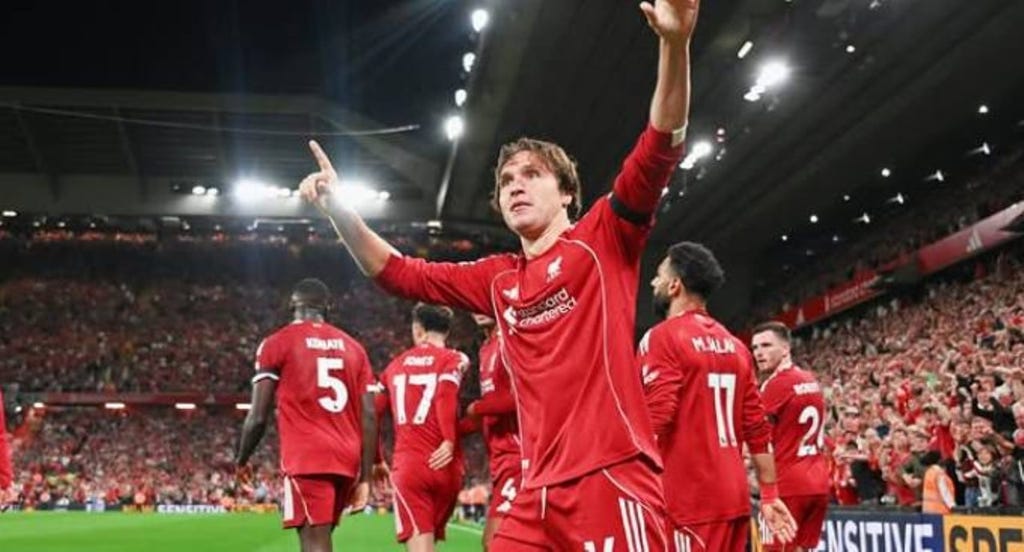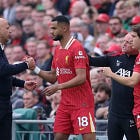The Match, The Stat: Liverpool 4-2 Bournemouth
Most of Liverpool's problems are occurring following a fast break.
All love and support to Antoine Semenyo.
There was much to enjoy in Liverpool’s 4-2 win over Bournemouth at Anfield on Friday night. Hugo Ekitike scored and assisted on his Premier League debut while Federico Chiesa delivered the decisive moment that his A-grade chant deserves.
The evening was rounded off by Mohamed Salah scoring in the season opener because a) it was happening, b) he was playing, and c) that’s just what he does. He’ll still be banging in goals in Augusts after the apocalypse, say in 2030 or 2031.
As Cody Gakpo was the beneficiary of Ekitike’s successful key pass in the Cherries’ box, all four forwards scored. With Florian Wirtz recording 15 counter pressures to immediately match the Reds’ 2024/25 high for the metric - by Dominik Szoboszlai at Tottenham - the new look front half of the Liverpool team has lots of selling points to recommend it.
But as with a mullet, there’s the back to worry about. Only seven times have the Reds failed to win a home game in which they led by two goals in the Premier League. Those matches were at least all draws. This game could easily have become the eighth of those, maybe even the first ever defeat in such circumstances.
There are easier teams to face than Bournemouth when trying to integrate several new players on an emotional evening. Even when the visitors’ summer transfer activity has depleted the side which finished third in the expected points table for 2024/25, they retain many excellent footballers.
Andoni Iraola is too good a coach for the loss of a few players to undermine the top class outfit he has developed too. When there was space to exploit, they charged through it.
If we include pre-season, this has become a recurrent source of pain for Liverpool in 2025/26. They have become far too open to being hit on the counter.
It’s important to not go overboard. The base of the midfield was expertly manned last season by Ryan Gravenberch and Alexis Mac Allister, who have not yet featured together this term. The latter had not played alongside Virgil van Dijk before Friday either.
Equally, Arne Slot can not afford for this issue to get out of hand, else opposing teams will know the Reds can be hurt in transition. Liverpool conceded 32 counter attack (a.k.a. fast break) shots in the league last season, 47 in all competitions. It’s a shade under one per game either way.
Detailed pre-season data is hard to obtain. It can involve extracting facts buried in the automated commentary. The sentence which appeared too often for shots allowed by Liverpool was ‘following a fast break’, though.
Preston had one such attempt, as did Athletic Club in match one of the double header. Milan had three, converting two of them. You could argue all four of their goals were counters of sort, even if Opta didn’t classify them all as such.
Crystal Palace didn’t have any fast break shots at Wembley. However, it took a sequence of just two passes to put Jean-Philippe Mateta clean through on goal in the move which led to their penalty. Two was all it took to set up their second equaliser too.
Bournemouth scored twice at Anfield via moves lasting just two and one pass respectively, with both the very definition of what Opta consider a counter attack. A shot in first half stoppage time by Evanilson was a third such chance. It was just as straightforward, with David Brooks collecting a clearance before carrying the ball roughly half the length of the pitch to set up the opportunity.
An ABF newsletter towards the end of last season assessed the Reds’ counter attack defence. It included the following chart, which showed their worst games for fast break shots allowed across a six-year period. The match against the Cherries now belongs on this shame log, with it the first in the group to see two goals conceded thanks to counter attacks.
Two fast break goals isn’t just high for a match, it’s a lot for a whole season. Liverpool allowed one in total in three of Jürgen Klopp’s final four league campaigns. In 2018/19, the Reds didn’t concede any. Antoine Semenyo’s brace on Friday gave birth to this remarkable piece of trivia:
Liverpool conceded two league goals to Opta-defined fast breaks last season. Liverpool have conceded two league goals to Opta-defined fast breaks this season.
Oh boy. The openness has been striking in comparison to Liverpool’s own build-up play. The sequences leading to Ekitike’s two goals featured 22 and 18 passes respectively; the three open play goals the Reds have conceded needed just five passes between them in total.
The return of Gravenberch with a fully fit Mac Allister can not come soon enough. They alone cannot consign this problem to history, though. As only Liverpool and Chelsea had more fast break shots than Newcastle last season, Slot has to resolve this issue within the next week.








Will the return of Gravenberch solve anything? Not if Liverpool persist in having seven or eight men ahead of the ball when they turn it over as happened for Semenyo's second...
“But as with a mullet, there’s the back to worry about.”
Brilliant!